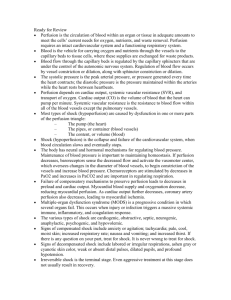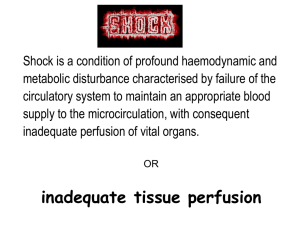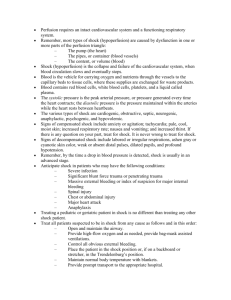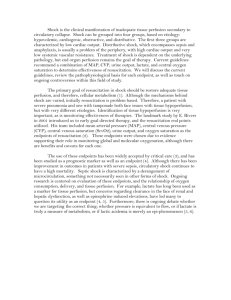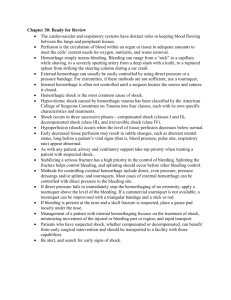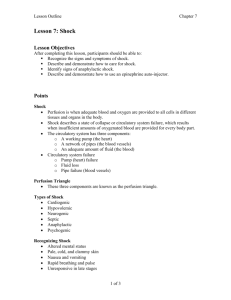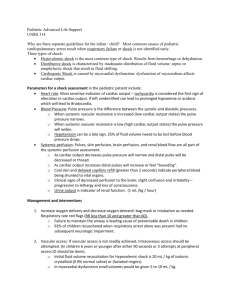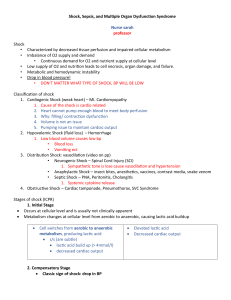Shock - Part 1
advertisement
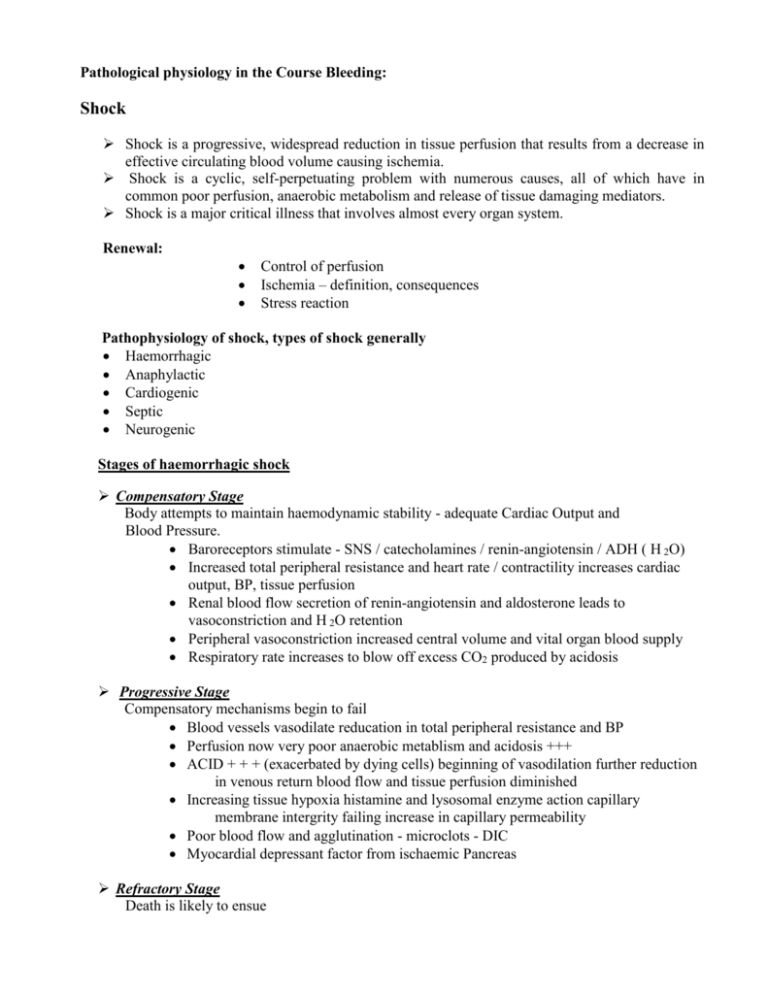
Pathological physiology in the Course Bleeding: Shock Shock is a progressive, widespread reduction in tissue perfusion that results from a decrease in effective circulating blood volume causing ischemia. Shock is a cyclic, self-perpetuating problem with numerous causes, all of which have in common poor perfusion, anaerobic metabolism and release of tissue damaging mediators. Shock is a major critical illness that involves almost every organ system. Renewal: Control of perfusion Ischemia – definition, consequences Stress reaction Pathophysiology of shock, types of shock generally Haemorrhagic Anaphylactic Cardiogenic Septic Neurogenic Stages of haemorrhagic shock Compensatory Stage Body attempts to maintain haemodynamic stability - adequate Cardiac Output and Blood Pressure. Baroreceptors stimulate - SNS / catecholamines / renin-angiotensin / ADH ( H 2O) Increased total peripheral resistance and heart rate / contractility increases cardiac output, BP, tissue perfusion Renal blood flow secretion of renin-angiotensin and aldosterone leads to vasoconstriction and H 2O retention Peripheral vasoconstriction increased central volume and vital organ blood supply Respiratory rate increases to blow off excess CO2 produced by acidosis Progressive Stage Compensatory mechanisms begin to fail Blood vessels vasodilate reducation in total peripheral resistance and BP Perfusion now very poor anaerobic metablism and acidosis +++ ACID + + + (exacerbated by dying cells) beginning of vasodilation further reduction in venous return blood flow and tissue perfusion diminished Increasing tissue hypoxia histamine and lysosomal enzyme action capillary membrane intergrity failing increase in capillary permeability Poor blood flow and agglutination - microclots - DIC Myocardial depressant factor from ischaemic Pancreas Refractory Stage Death is likely to ensue loss of autoregulation in microcirculation capillary permeability and fluid shifts into interstitial space venous return and cardiac output almost negligible reduced cardiac output leads to severely impaired perfusion to tissues Inadequate organ perfusion has significant consequences for myocardium, lungs, kidneys, brain, liver, pancreas, peripheries, gastrointestinal tract leads to an overwhelming metabolic acidosis (lactic acidosis, impaired acid - base regulatory mechanisms) disruption of clotting factors - coagulopathies – DIC development of shock organs Signs and Symptoms of Hypovolemic Shock The clinical manifestations are due to the hemodynamic impairment, to the compensatory efforts, and eventually to the effects of the tissue anoxia. 1) Cardinal finding due to hemodynamic impairment - low blood pressure (BP). Official definition of shock requires a systolic blood pressure (SBP) under 90. Early stages: manifested only in the upright position (postural hypotension). When fully evident, it does not affect both components of the BP to the same extent. SBP is down (below 90, by definition), but the diastolic (DBP) is relatively preserved as a consequence of compensatory vasoconstriction. Thus, there is a “narrow pulse pressure” = little distance between the low systolic value and the almost normal diastolic value. As the patient deteriorates or blood loss becomes overwhelming, both components of the BP will plummet 2) Tachycardia : In an effort to Increase perfusion, pulse rate increases. The patient in shock typically has a rate >90. (Pearl: Pressure under 90, pulse over 90). The pulse is also weak, “thready”. It is often not perceptible at all in the usual peripheral locations, but found only in major vessels (carotid, femoral), and sometimes only by cardiac auscultation. This feature has great diagnostic value, because many other things (fear, anger, pain, fever, excitement, exercise) will increase the pulse rate; but, none of these other situations will affect its quality. A patient with a fast, but strong, bounding pulse is not in shock. 3) Decreased urine output: Urine output has to be measured by the hour. Normal hourly urinary output is around 1 cc /kg body weight per hour. Normal range is 0.5-2 cc/kg/hr. Patients in shock will be below 0.5 cc/kg/hr. The urine is dark, heavily concentrated, with high concentration of all components, except sodium (which is the force driving the renal retention of fluid). In very severe states of shock, when perfusion pressure is too low to effect glomerular filtration, urinary output will approach zero. 4) Low central venous pressure (CVP) and low atrial pressure: The veins are empty and collapsed. Instead of the usual 5-10 cm of water, the CVP approaches zero. (A very important point for differential diagnosis!) 5) Other clinical signs/symptoms - primarily due to compensatory efforts Pale skin - Extreme vasoconstriction redirecting the remaining perfusion to the high priority tissues deprives the skin of blood. Cold skin / shivering - lack of warm blood flowing to the skin Sweating - The same nerves that trigger vasoconstriction also trigger the sweat glands. The skin feels “cold and clammy". Thirst “Sense of impending doom” - Patient is fearful something ‘bad’ is going to happen. Treatment of Hypovolemic (Hemorrhagic) Shock The patient needs blood, but it is not instantly available. It must be brought from the blood bank to the ER, has to be typed and cross-matched, and be warmed. At best, it will take at least l hr to get blood. 1) Stop the bleeding. Whenever possible, surgical intervention to stop the bleeding should precede resuscitation and blood transfusion. The first order of business in a setting of penetrating or severe blunt trauma is to control the bleeding sites, and then start massive fluid infusion. 2) Resuscitation Phase - done with instantly available fluids while waiting for blood. Typically done with 1-2 liters of Ringer’s lactate (or a similar balanced electrolyte solution that uses acetate instead of lactate) infused in the first 20-30 min. Blood (packed red cells) then follow 3) Blood Transfusion


